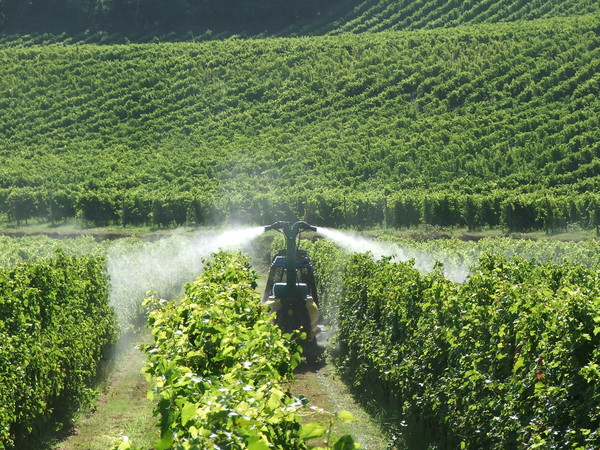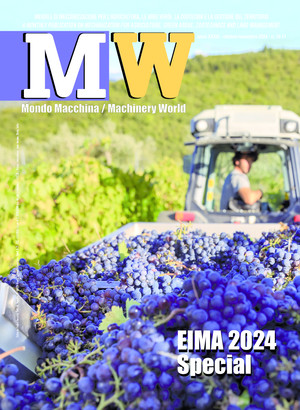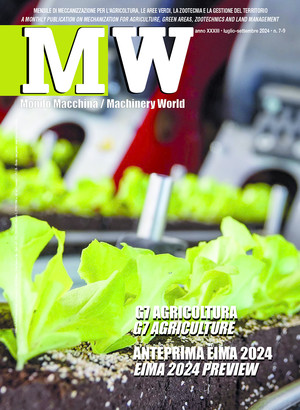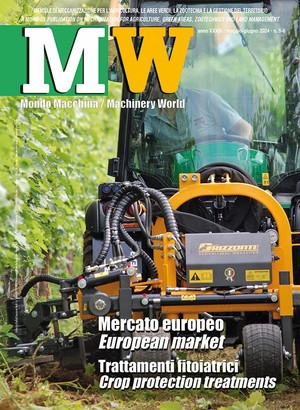
Innovative technologies for reducing the use of pesticides
Crop protection treatments performed with sprayers can be less accurate as a result of the drift effect. To address this issue, the manufacturers have developed several technology solutions to optimize treatments
The use of agrochemicals is a hotly debated issue in Europe. Just recently, it has been at the center of an access debate about the advisability of envisaging a tightening of the standards currently in force. Standards are already particularly strict in terms of the requirements to be observed during construction and controls relating to machinery, use procedures, and the subsequent cleaning of equipment. With this in mind, the Italian agro-mechanical industry has always set itself the goal of being "ahead of the times."That is, to develop advanced technological solutions that would make it possible to rationalize the use of agrochemicals, guaranteeing the full sustainability and healthiness of production.
Contrary to what happens in treatments carried out with spray booms on herbaceous crops where both the force of gravity and the proximity to the target "help" the product to deposit in percentages almost never less than 90% of the volume sprayed, paradoxically, in treatments carried out with sprayers, the situation is quite different. It is not very rare to come across diametrically opposite situations, with very small percentages of product depositing on the leaves and the bulk of the phytoiatric mixture not going correctly to target. This situation is due both to the manner in which treatment is usually carried out (i.e., the need to use imposing air currents to convey the droplets to the plants by overcoming the force of gravity), to vegetation conditions (since in early spring treatments the foliar "barrier" is poor), and to environmental conditions (with air currents and high temperatures that favor off-target transport and evaporation of the sprayed product).’Professionals in the field are well aware that in order to increase the efficiency of sprayer distribution, it is necessary first of all to limit the "drift" effect, the term of which is well specified by ISO 22866 as the "movement of the pesticide into the atmosphere from the treated area to any site other than the target, at the time when the distribution is operated. Exacerbating the drift problem is certainly also the presence in the area of a rather old machinery fleet (with an estimated average age of around 20 years), on which it is nevertheless possible to go to work by making appropriate adjustments and/or replacements of parts and components to improve distribution efficiency drastically.
Plant protection product drift can be reduced not only by appropriate technical interventions on machinery but also through the use of indirect measures such as, for example, the interposition of buffer strips (untreated areas) between the field and the areas to be protected, the planting of hedges, or other physical barriers represented, for example, by windbreaks or hail nets.
Measures to be implemented on the machinery include a number of technical measures, among which are the use of adjuvants with an anti-drift function, accessories such as anti-drift nozzles, or the use of special screens designed to prevent air from being conveyed to the outside of the plot in treatments to the last rows. Other technical interventions concern the reduction of airflow rates, the use of electronic controllers to adjust the flow rate to the forward speed, and the use of optical or ultrasonic sensors to prevent spraying if there are "holes" in the vegetation or to stop it automatically and precisely at the end of the rows.
"Next-gen" technologies. For the most recently built machinery, i.e., those complying with Directive 2009/127/EC of 2011, some important basic technical solutions are already set in place by default, since with this standard, manufacturers have already had to introduce certain technical equipment even on the most "basic" models in order to stop spraying altogether by acting on a single control, to easily fill the main tank and empty it completely, to define a priori and precisely and reliably the volume to be distributed per unit area. The machines must also necessarily be equipped with a clean water tank in order to be able to carry out internal washing of the sprayer at the end of treatment, and they must also be designed to minimize both dispersion of the sprayed product by drift and percolation to the ground.
The only technical solution that today makes it possible to drastically reduce the share of product dispersed into the environment to the point of effectively nullifying it is the use of sprayers with recovery panels that create a sort of "tunnel" inside which the treatment is carried out and using the walls to intercept the product once it has passed the target vegetation, then allow it to be recovered and reused. With this technology, up to 80 percent of the product can be saved in the first few treatments. However, it should be considered that the magnitude of this saving will then decrease as the barrier effect created by the vegetation increases, to be - in the last treatments - between 5% and 10%.
Sprayers with recovery panels are very recently developed machines that are not exactly economical and cannot be used in all situations since they are bulkier and more difficult to maneuver than conventional models, particularly on slopes. Yet, there is another aspect to consider. These vehicles recover a variable amount of the product that "doesn't get on target," which makes it impossible to determine the amount of mixture distributed per hectare accurately. This problem can be solved, in part if not entirely, by state-of-the-art onboard computers that can measure the amount of product sprayed and recovered and then inform the operator in real time about the remaining range.
Instead, many solutions can be adopted to limit drift with modifications that can be implemented on even quite old machinery.
Anti-drift nozzles. Whether or not equipped with the air injection system, they are characterized by producing larger droplets than those emitted by conventional nozzles (at the same flow rate and operating pressure). Their efficacy is maximized within a given range of operating pressures. While their use with systemic products, in fact, brings only advantages, their use with contact or coverage products should be judged wisely since it is known that employing larger caliber droplets and keeping the doses distributed per unit area unchanged results in worsening coverage. Furthermore, although their effectiveness in containing drift is very high when these are used on spray booms, in use on sprayers, this phenomenon is less evident on sprays because of the presence of the strong air currents used to launch the droplets from bottom to top and above all when there are vegetated masses incapable of forming a thick, continuous barrier on which the sprayed can settle.
Antidye adjuvants. Whereas in order to be effectively identified as "anti-drift," the adjuvant must be registered as such by the Ministry of Health, it is necessary to be aware that its efficacy also depends on meeting the label directions, which usually specify the type of nozzles and the operating pressure ranges for which the adjuvant is usable.
Airflow closing bulkheads. The use of movable screens that close off the airflow directed outward from the plot when spraying the perimeter rows makes it possible to substantially reduce the drift outward, but it should also be considered that a similar effect, albeit of slightly lesser magnitude, can also be obtained with machinery not equipped with these devices.
The electrostatic charge of sprinkled particles. The Coulomb principle allows for the establishment of an attractive force between two bodies with opposite signs of charge and repulsive in the opposite case.’ Given that vegetation naturally possesses a weak natural electrostatic charge, it is possible to cause liquid particles passing adjacent to it to be attracted toward it when they possess a charge of the opposite sign, thus reducing their scattering beyond the target and, thus, their drift. The droplets, all having the same charge, repel each other without aggregating or increasing in size. This phenomenon improves the spatial distribution of the droplets, especially when the electrostatically charged droplets are small and move slowly near the vegetation. Like all technical solutions, this one has some disadvantages. For instance, it's harder to get the phytoiatric mixture to penetrate very thick vegetation masses or clusters.
Flow rate adjustment as a function of forward speed. Modern DPA regulating units make it possible to achieve distribution proportional to forward speed through the use of electronic controllers. These controllers ensure that the amount of liquid dispensed per unit area remains constant at all times by appropriately increasing the pressure as speed increases and decreasing it when it drops. Such devices, which in any case do not directly intervene in drift control, are rather simple to install, even on rather old vehicles. DPA units on board such machines, which are equipped with simple constant-pressure control systems, help to minimize waste, and greatly limit the inevitable overdoses due to the fact that the optimum speed has not yet been reached at the beginning of the row. Furthermore, these electronic control units can interface with any georeferencing devices on the tractor, even to conduct variable-rate treatments while respecting preloaded prescription maps.
On-off sensors. With conventional methods, within the row the phytoiatric mixture is continuously dispensed, even in the presence of gaps left by any explants.’ With the use of special sensors, such gaps can be detected, temporarily interrupting the spray process. This task is commonly performed by ultrasonic sensors, which, in addition to proving particularly suitable for this application, are robust, inexpensive, rather resistant to chemical components and have a high IP protection class. They also allow for the monitoring of distances and, in fact, also find fruitful use in automating the adjustment of heights from the ground of machinery equipped with excavating bulkheads. Single-plane Lidars have recently appeared on the market, increasing accuracy in defining the shape of the canopy. In both instances, their use is only possible on machinery that is already equipped with electronic control units for section control.
Sensors, variable-rate distribution maps. The next step is using sensors capable of making prescription maps in real-time (or prior to the execution of product distribution). These technologies are promising and still capable of considerable development. However, they are rather complicated to install on machines already in use on farms, even though they may already be equipped with electronic control units. Start-ups and universities in Europe and the United States have already realized some similar solutions. However, the development of a prototype of AgroSenseBot, a robotic atomizer jointly realized by the University of Milan and the Politecnico di Milano, in collaboration with Caffini and Tecomec, is particularly interesting. In this case, it is a tracked sprayer that will be able to carry out variable rate treatments by modulating both the water flow rate delivered by each individual nozzle and the airflow rate of the fan in order to always maintain optimal vegetation coverage at different heights and in the presence of various amounts of vegetated masses, using a set of absolutely redundant information coming from other types of sensors mounted onboard, also in order to benchmark the different kinds of commercial sensors that can be used on these machines to optimize their operation.
The Caffini Synthesis Kit. The modifications required to install the kit proposed by Caffini and developed in collaboration with the Consorzio di Tutela Prosecco Docg and the University of Padua are of the utmost importance. The kit includes new nozzles and a new fan unit with conveyors to regulate the airflow, which optimizes it for conducting treatments on espalier-trained vines. It also optimizes the distribution of phytosanitary products compared to that which can be carried out with classic sprayers with nozzles arranged in a radial pattern.








